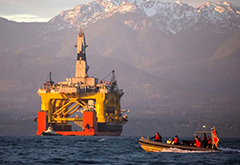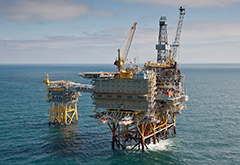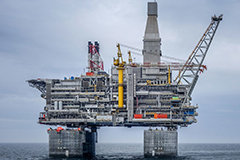1- Perdido Oil Platform - US:
Perdido is the deepest floating oil platform in the world at a water depth of about 2450 meters (8000 feet) operated by the Shell Oil Company in the Gulf of Mexico. It is located in the Perdido fold belt which is a rich discovery of crude oil and natural gas. The platform's peak production will be 100,000 barrels of oil equivalent per day. At 267 meters, the Perdido is nearly as tall as the Eiffel Tower. More details
Petronius is a deepwater compliant tower oil platform operated by Chevron Corporation and Marathon Oil in the Gulf of Mexico, 210 km southeast of New Orleans, United States. A compliant piled tower design, it is 609.9 metres (2,001 ft) high, and was arguably the tallest free-standing structure in the world, until surpassed by the Burj Khalifa in 2008, although this claim is disputed since only 75 metres of the platform are above water. The multi-deck topsides are 64 metres by 43 metres by 18.3 metres high and hold 21 well slots, and the entire structure weighs around 43,000 tons. Around 8,000 m3 (50,000 barrels) of oil and 2,000,000 m3 (70 million cubic feet) of natural gas are extracted daily by the rig. More details
3- CNOOC 981 Oil Platform - China:
On May 9, 2012 China's first deep-water drilling platform CNOOC 981 successfully completed its first drilling on the South China Sea, and the drill reached the layer of the ground 1,500 meters under the sea surface in the 6-1 area of the Li Bay of the South China Sea. It is the first time that China has carried out deep-water oil and gas exploitation independently, indicating that the deep-water strategy of China's offshore oil industry has taken a practical step. the CNOOC 981 is equipped with eight 44,000-kilowatt diesel generators whose total capacity can support the electricity consumption of a medium-sized city. It has eight thrusters, and the power of each of them is equal to that of five locomotives. More details
4. Baldpate Oil Platform - US:
Baldpate is located in 1,650ft of water, in Garden Banks (GB) block 260, 120 miles off the Louisiana coast. This is the first free-standing offshore compliant tower ever, as well as one of the tallest free-standing structures in the world. The tip of the flare boom extends 1,902ft above the seafloor. The discovery well was drilled by the semisubmersible Ocean Rover in late 1991, revealing 180ft of net pay. Total output from seven planned production wells will exceed 50,000b/d and 150,000MMSCFD. Anticipated recoverable reserves from Baldpate and Baldpate North total 104 million barrels of oil equivalent (MMBOE), of which 60% is oil and the remainder is gas. Production from the platform reached its peak in the first half of 1999, at rates approaching facility oil and gas capacities. More details
Atlantis platform is the deepest moored floating dual oil and gas production facility in the world. The platform is located 190 miles south of New Orleans in 7,070ft (2,150m) of water, the field itself occupying five blocks – Green Canyon 699, 700, 742, 743 and 744 – with water depths ranging between 4,400ft and 7,100ft (1,338m and 2,158m). Originally scheduled to start in 2006, the hurricane of the 2005 season delayed progress and hiked prices, Atlantis finally produced its first oil in October 2007, with full commissioning – and a ramp up in production – following in mid-December. Initially producing at a daily rate of around 10,000 barrels of oil, Atlantis reached plateau production by the end of 2008. It has a production capacity of 200,000 barrels of oil and 180 million cubic feet of gas a day. More details
6. Troll A platform - Norway:
The Troll A platform is a condeep offshore natural gas platform in the Troll gas field off the west coast of Norway. It is the tallest structure that has ever been moved to another position, relative to the surface of the Earth, and is among the largest and most complex engineering projects in history. The platform was a televised sensation when it was towed into the North Sea in 1996, where it is now operated by Statoil. More details
7. Eirik Raude Oil Rig:
Deepwater oil operations are pushing technological creativity to the limits. The Eirik Raude drilling rig demonstrates the industry's ability to adapt to the planet's most rigorous conditions. The world rig market can offer a large and diverse range of units, but relatively few of these are able not only to operate in deep water but also to tackle cold, stormy weather conditions. So a group of Norwegian investors decided to construct the sensational new Eirik Raude rig, which has been specially designed to work in ultradeep water down to 3,000 meters. More details
8. Veslefrikk Platforms:
Veslefrikk platforms in the North Sea outside Bergen produce oil and gas. The oil is sent by pipeline to the Stureterminal terminal and the gas is sent by pipeline to Germany . Veslefrikk has two platforms (A and B). Veslefrikk A is a fixed steel platform ("jacket") with drilling and riser pipes. Veslefrikk B is a semi submersible platform where most of the production takes place. The platforms are connected to a bridge. This bridge is taken up in bad weather. There are also flexible risers between the platforms where the well flows from A to B, and the processed oil and gas return from B to A, where it is passed on to the pipeline. Inn to Veslefrikk A also comes from hydrocarbons from the Huldra field , which is mixed with Veslefrikk's own production and sent on. Veslefrikk A has lane lifeboats, while Veslefrikk B has plunge boats. More details
9. Emerald Vantage Jackup Rig:
A jackup rig or a self-elevating unit is a type of mobile platform that consists of a buoyant hull fitted with a number of movable legs, capable of raising its hull over the surface of the sea. The buoyant hull enables transportation of the unit and all attached machinery to a desired location. Once on location the hull is raised to the required elevation above the sea surface supported by the sea bed. The legs of such units may be designed to penetrate the sea bed, may be fitted with enlarged sections or footings, or may be attached to a bottom mat. Generally jackup rigs are not self-propelled and rely on tugs or heavy lift ships for transportation. More details
10. Transocean Polar Pioneer:
The Polar Pioneer was one of two harsh environment drilling rigs Shell contracted to carry out drilling operations in the Chukchi and Beaufort Seas. But exploratory drilling in Chukchi Sea failed to find enough recoverable oil, forcing Shell to announce that it was abandoning its Alaskan Arctic drilling ambitions all together after spending about $7 billion. The Polar Pioneer received some unwanted media attention leading up to this summer’s drilling program when it was boarded by Greenpeace activists as it sailed across the Pacific Ocean and later as it was met by protests in Seattle. More details
11. Heimdal Platform:
Heimdal (Norwegian: Heimdalfeltet) is an offshore natural gas field in the North Sea located 212 kilometers (132 mi) northwest of the Stavanger, Norway. Heimdal serves as a connection hub for processing and distribution of natural gas from satellite fields. The field was discovered in 1972. The depth of the sea at location is 120 metres (390 ft). The field was developed with an integrated drilling, production and accommodation facility with a steel jacket including a riser facility in 1999. The gas from the field is transported to Kårstø as well as to St. Fergus in Scotland. After construction of the Heimdal gas center, a new gas pipeline was connected to the existing one from Frigg gas field to St. Fergus. The gas is also transported to Grane oil field for gas injection. The condensate is sent by pipeline to Brae oilfield. Heimdal also gets gas from the Oseberg field center for further transportation through Statpipe system. More details
12. Berkut Platform:
The platform “Berkut” is 25 kilometers from the northern part of Sakhalin Island, offshore in the Sea of Okhotsk, on the Russian Pacific coast. According to experts, after reaching full capacity, the platform will be the largest in the world by the volume of hydrocarbons produced per year. The platform “Berkut” is specifically designed to operate in harsh subarctic conditions and can withstand waves up to 18 meters, pressure of ice fields up to two meters thick and temperatures down to minus 44°C. The weight of the base of the platform – 160,000 tons, its perimeter – 100 at 133 meters, height – 50 meters. The platform is designed for production of up to 4.5 million tons of hydrocarbons per year. More details
13. Brage Platform:
Brage platform in the Norwegian North Sea. Brage is an offshore oil field in the North Sea located 120 km (75 mi) northwest of the city of Bergen on the western coast of Norway and 13 km (8.1 mi) east of Oseberg Field Center. The field also contains gas. The water depth at the location is 140 metres (460 ft). The field was developed with a fixed integrated production, drilling and accommodation facility The oil from the field is pumped through a pipeline to Oseberg A facility from where it is transported to Sture terminal via Oseberg Transport System. The gas from the field is exported through Statpipe system to Kårstø. It is estimated that Brage may hold up to 20,000,000 barrels (3,200,000 m3) to 25,000,000 barrels (4,000,000 m3) of recoverable oil. More details
14. Offshore Oil Drilling History:
Offshore drilling is a mechanical process where a wellbore is drilled below the seabed. It is typically carried out in order to explore for and subsequently extract petroleum which lies in rock formations beneath the seabed. Most commonly, the term is used to describe drilling activities on the continental shelf, though the term can also be applied to drilling in lakes, inshore waters and inland seas. Offshore drilling presents environmental challenges, both from the produced hydrocarbons and the materials used during the drilling operation. Controversies include the ongoing U.S. offshore drilling debate. More details
14. Offshore Oil Drilling History:
15. Prirazlomnoye Oil Platform:
Prirazlomnoye field is an Arctic offshore oilfield located in the Pechora Sea, south of Novaya Zemlya, Russia, the first commercial offshore oil development in the Russian Arctic sector. The field development is based on the single stationary Prirazlomnaya platform, which is the first Arctic-class ice-resistant oil platform in the world. Commercial drilling was planned to begin in early 2012, however it was delayed at least until the Spring of 2013 due to protester's "safety concerns". Safety concerns have been raised about Prirazlomnoye platform, citing use of decommissioned equipment (the 1984 TLP upper section of the rig), however Gazprom’s oil spill response plan for Prirazlomnaya was renewed in 2014. More details
16. Hibernia Oil Platform:
Hibernia is an oil field in the North Atlantic Ocean, approximately 315 kilometres (196 mi) east-southeast of St. John's, Newfoundland, Canada, in 80 m of water. The production platform Hibernia is the world's largest oil platform (by weight) and consists of a 37,000 t (41,000 short tons) integrated topsides facility mounted on a 600,000 t (660,000 short tons) gravity base structure. The platform was towed to its final site, and 450,000 t (500,000 short tons) of solid ballast were added to secure it in place. Inside the gravity base structure are storage tanks for 1.3 million barrels (210,000 m3) of crude oil. More details
17. Pioneer Floating Oil Rig:
The BW Pioneer FPSO (a Floating, Production, Storage and Offloading vessel platform) is the first FPSO to produce oil and gas in the U.S. Gulf of Mexico, and it is capable of processing 80,000 barrels of oil and 500,000 cubic meters of gas per day and of storing 500,000 barrels of oil. The vessel is fitted with a detachable mooring system that allows it to sail to sheltered areas during hurricanes and storms, providing security to both the crew and to the environment as well as preserving equipment. A floating production storage and offloading (FPSO) unit is a floating vessel used by the offshore oil and gas industry for the production and processing of hydrocarbons, and for the storage of oil. More details
18. Brent Bravo Platform:
The Brent field is an oil and gas field located in the East Shetland Basin of the North Sea, 186 kilometres (116 mi) north-east of Lerwick, Shetland Islands, Scotland, at the water depth of 140 metres (460 ft). The field operated by Shell UK Limited was once one of the most productive parts of the UK's offshore assets but has reached the stage where production is no longer economically viable. Decommissioning of the Brent field is ongoing and will be completed in the early 2020s. Production started-up on 11 November 1976, and on 13 December 1976 the first tanker was loaded. The Brent field oil is extracted by four platforms in an irregular SSW-NNE line. More details
19. Petronas Floating LNG Facility:
Floating liquefied natural gas (FLNG) refers to water-based liquefied natural gas (LNG) operations employing technologies designed to enable the development of offshore natural gas resources. Floating above an offshore natural gas field, the FLNG facility produces, liquefies, stores and transfers LNG (and potentially LPG and condensate) at sea before carriers ship it directly to markets. The world's first completed FLNG production facility is the PFLNG Satu located in Kanowit gas field off the shore of Sarawak in Malaysia. Petronas Floating LNG FacilityPetronas is the owner of the platform and first cargo was loaded onto the 150,200-cbm Seri Camellia LNG carrier on 03 April 2017. More details
20. Prelude FLNG:
Prelude FLNG is the world's largest floating liquefied natural gas platform as well as the largest offshore facility ever constructed. The Prelude was built by the Technip / Samsung Consortium (TSC) in South Korea for a joint venture between Royal Dutch Shell, KOGAS, and Inpex. It is 488 metres (1,601 ft) long, 74 metres (243 ft) wide, and made with more than 260,000 tonnes of steel. The vessel will displace around 660,000 tonnes when fully loaded, more than five times the displacement of a Nimitz-class aircraft carrier. The main double-hulled structure was built by the Technip Samsung Consortium in the Samsung Heavy Industries Geoje shipyard in South Korea. More details



















